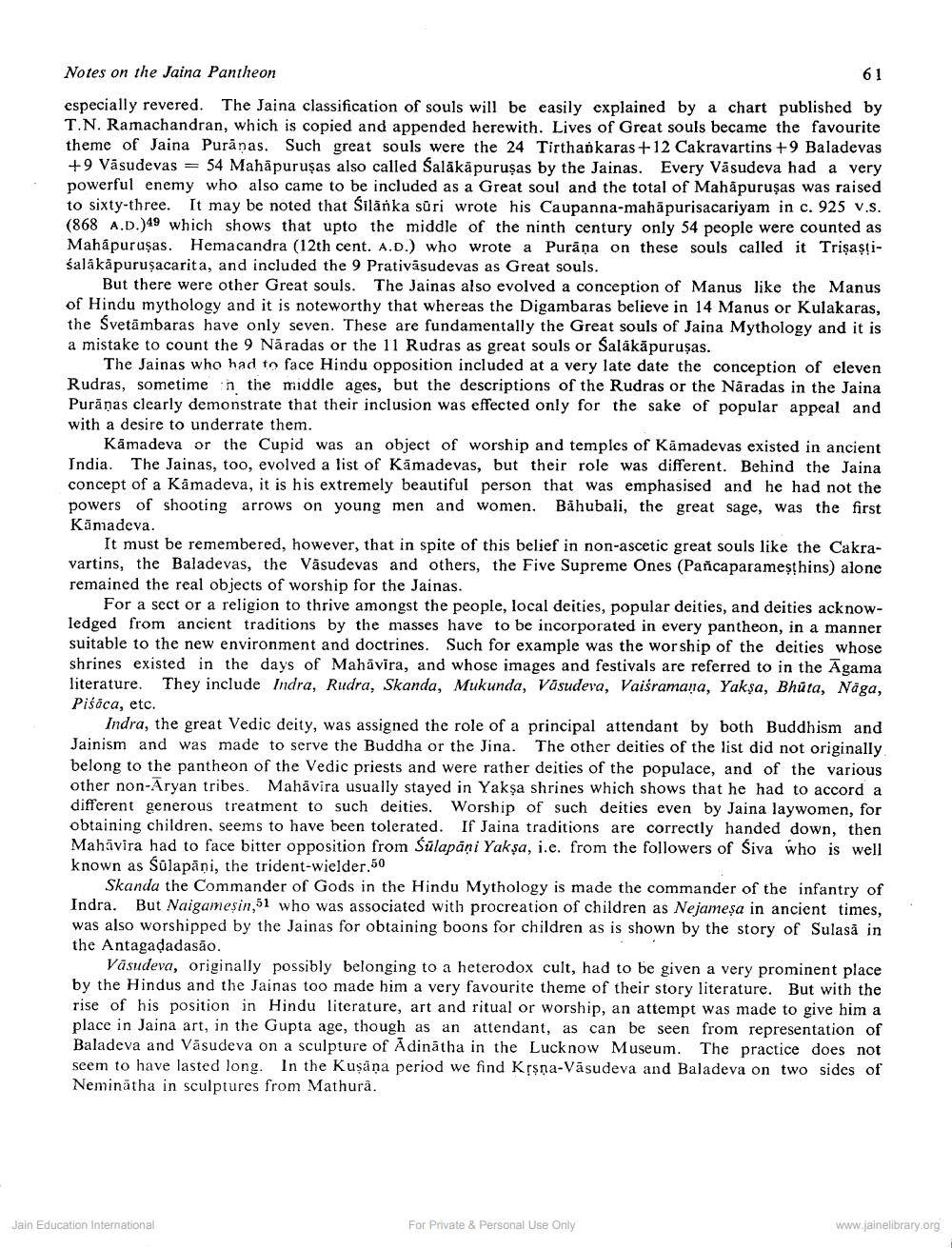________________
Notes on the Jaina Pantheon
61
especially revered. The Jaina classification of souls will be easily explained by a chart published by T.N. Ramachandran, which is copied and appended herewith. Lives of Great souls became the favourite theme of Jaina Puranas. Such great souls were the 24 Tirthaokaras +12 Cakravartins +9 Baladevas +9 Vasudevas = 54 Mahāpuruşas also called Salākāpurusas by the Jainas. Every Vasudeva had a very powerful enemy who also came to be included as a Great soul and the total of Mahapuruşas was raised to sixty-three. It may be noted that Silānka sūri wrote his Caupanna-mahapurisacariyam in c. 925 v.s. (868 A.D.)49 which shows that upto the middle of the ninth century only 54 people were counted as Mahapuruşas. Hemacandra (12th cent. A.D.) who wrote a Purana on these souls called it Trişaşțisalākäpuruşacarita, and included the 9 Prativasudevas as Great souls.
But there were other Great souls. The Jainas also evolved a conception of Manus like the Manus of Hindu mythology and it is noteworthy that whereas the Digambaras believe in 14 Manus or Kulakaras, the Svetämbaras have only seven. These are fundamentally the Great souls of Jaina Mythology and it is a mistake to count the 9 Näradas or the 11 Rudras as great souls or Salákāpuruşas.
The Jainas who had to face Hindu opposition included at a very late date the conception of eleven Rudras, sometime in the middle ages, but the descriptions of the Rudras or the Náradas in the Jaina Purānas clearly demonstrate that their inclusion was effected only for the sake of popular appeal and with a desire to underrate them.
Kamadeva or the Cupid was an object of worship and temples of Kamadevas existed in ancient India. The Jainas, too, evolved a list of Kamadevas, but their role was different. Behind the Jaina concept of a Kamadeva, it is his extremely beautiful person that was emphasised and he had not the powers of shooting arrows on young men and women. Bahubali, the great sage, was the first Kamadeva.
It must be remembered, however, that in spite of this belief in non-ascetic great souls like the Cakravartins, the Baladevas, the Vasudevas and others, the Five Supreme Ones (Pañcaparameşthins) alone remained the real objects of worship for the Jainas.
For a sect or a religion to thrive amongst the people, local deities, popular deities, and deities acknowledged from ancient traditions by the masses have to be incorporated in every pantheon, in a manner suitable to the new environment and doctrines. Such for example was the worship of the deities whose shrines existed in the days of Mahavira, and whose images and festivals are referred to in the Agama literature. They include Indra, Rudra, Skanda, Mukunda, Vasudeva, Vaiśramana, Yaksa, Bhūta, Nāga, Piśáca, etc.
Indra, the great Vedic deity, was assigned the role of a principal attendant by both Buddhism and Jainism and was made to serve the Buddha or the Jina. The other deities of the list did not originally belong to the pantheon of the Vedic priests and were rather deities of the populace, and of the various other non-Aryan tribes. Mahavira usually stayed in Yakşa shrines which shows that he had to accord a different generous treatment to such deities. Worship of such deities even by Jaina laywomen, for obtaining children, seems to have been tolerated. If Jaina traditions are correctly handed down, then Mahavira had to face bitter opposition from Sūlapāņi Yaksa, i.e. from the followers of Siva who is well known as Sūlapāņi, the trident-wielder 50
Skanda the Commander of Gods in the Hindu Mythology is made the commander of the infantry of Indra. But Naigameşin,51 who was associated with procreation of children as Nejameșa in ancient times, was also worshipped by the Jainas for obtaining boons for children as is shown by the story of Sulasă in the Antagadadasão.
Vasudeva, originally possibly belonging to a heterodox cult, had to be given a very prominent place by the Hindus and the Jainas too made him a very favourite theme of their story literature. But with the rise of his position in Hindu literature, art and ritual or worship, an attempt was made to give him a place in Jaina art, in the Gupta age, though as an attendant, as can be seen from representation of Baladeva and Vasudeva on a sculpture of Adinatha in the Lucknow Museum. The practice does not seem to have lasted long. In the Kuşåna period we find Krsna-Vasudeva and Baladeva on two sides of Neminatha in sculptures from Mathurå.
Jain Education International
For Private & Personal Use Only
www.jainelibrary.org




